P I P A
muzicafe :: KLASİK MÜZİK :: HAFİF MÜZİK :: ŞARKI SÖZLERİ :: MUZİCAFE SÖYLEŞİLER
1 sayfadaki 1 sayfası
 P I P A
P I P A
The pipa (Chinese: 琵琶; pinyin: pípá) is a four-stringed Chinese musical instrument, belonging to the plucked category of instruments (弹拨乐器/彈撥樂器). Sometimes called the Chinese lute, the instrument has a pear-shaped wooden body with a varying number of frets ranging from 12–26. Another Chinese 4 string plucked lute is the liuqin, which looks like a smaller version of the pipa.
The pipa appeared in the Qin Dynasty (221 - 206 BCE) and was developed during the Han Dynasty. It is one of the most popular Chinese instruments and has been played for nearly two thousand years in China. Several related instruments in East and Southeast Asia are derived from the pipa; these include the Japanese biwa, the Vietnamese đàn tỳ bà, and the Korean bipa. The Korean instrument is the only one of the three that is no longer used. Attempts to revive the instrument have failed, although examples survive in museums.
The pipa (Çinli: 琵琶; pinyin: pipa) Bir dört telli Çinli enstrüman, Araçların koparıp kategorisi (弹拨 乐器 / 弹拨 乐器) ait. Bazen Çin denir kopuz, Enstrüman 12-26 arasında değişen perdelerin bir değişen sayıda bir armut biçimli ahşap bir gövdeye sahip. Ud koparıp bir başka Çinli 4 dize olduğunu liuqin, Hangi pipa daha küçük bir versiyonu gibi görünüyor.
The pipa çıktı Qin Hanedanı (221-206 M.Ö.) ve sırasında geliştirildi Han Hanedanı. O ve en popüler Çin araçlardan biridir Çin'de yaklaşık iki bin yıldır oynanmaktadır. Birkaç ilgili belgeleri de Doğu ve Güneydoğu Asya elde edilir pipa; Bu içerir Japon Biwa, Vietnam Djan ty baVe Korece bipa. Kore alet artık kullanılan üç sadece bir tanesidir. örnekleri müzelerde hayatta olmasına rağmen araç canlandırmak için girişimler, başarısız oldu.
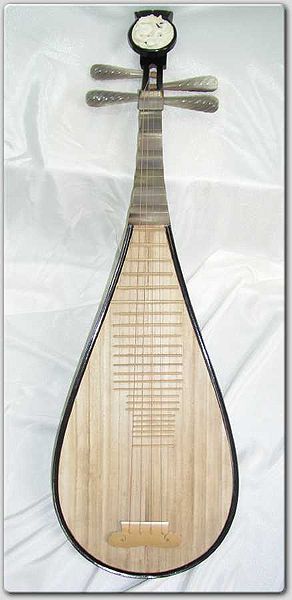

The name "pípá" is made up of two Chinese syllables, "pí" (琵) and "pá" (琶). These are the two most common ways of playing this instrument. "Pí" is to push the fingers of the right hand from right to left, thus more than one finger can be used at a time striking multiple notes, and "pá" is to pull the thumb of the right hand from left to right, in the opposite direction. The strings were originally played using a large plectrum in the Tang Dynasty, then gradually replaced by the fingernails of the right hand. Since the revolutions in Chinese instrument making during the 20th century, the softer twisted silk strings of earlier times have been exchanged for nylon-wound steel strings, which are far too strong for human fingernails, so false nails are now used, constructed of plastic or tortoise-shell, and affixed to the fingertips with the player's choice of elastic tape.
Adı "pipa" iki Çinli hece oluşur, "Pi" (琵) ve "pa" (琶). Bu bu enstrüman çalma en yaygın iki yolu vardır. "Pí" ve birden fazla parmak birden notlar çarpıcı bir anda kullanılabilir böylece, sağdan sola sağ elin parmakları bas etmektir "pa" soldan sağa sağ elinin başparmağı çekmek için, ters yönde. Dizeleri ilk kullanan oynandı büyük bir mızrap içinde Tang Hanedanı, Daha sonra yavaş yavaş sağ el tırnakları ile değiştirilir. 20. yüzyılda Çin alet yapımında devrimler bu yana, eski zamanların yumuşak bükülmüş ipek dizeleri insan tırnaklar için çok çok güçlü naylon yara çelik dizeleri, takas edilmiş, bu nedenle sahte tırnaklar şimdi plastik veya inşa kullanılır kaplumbağa kabuğu ve elastik bant oyuncunun seçimi ile parmak yapıştırılmıştır.
Development and Construction
A Tang Dynasty five-stringed pipaPrototypes of the pipa already existed in China in the Qin Dynasty (221 BC–206 BC). At that time, there were two types of pipa. One was straight-necked, with a round sound box constructed from lacquered Paulownia wood, and two faces mounted with leather. The other was believed to be inspired by the primitive forms of zheng, konghou, and zou. It also has a straight neck, a round sound box, and also four strings, along with twelve standards of notes. This model was later developed into the instrument known today as the ruan named after Ruan Xian, one of the Seven Sages of the Bamboo Grove. The modern pipa is closer to the instrument which originated in Persia/Middle-East (where it was called barbat) and was introduced into China beginning in the late Jin Dynasty (265–420 A.D.). By the Tang era, the pipa had become popular in the imperial court. It had a crooked neck, 4 or 5 silk strings, and 5 or 6 frets, and was played with a plectrum in a horizontal position. As the ages went by, the crooked neck was replaced by a straight one, the number of frets increased to between 14 or 16, and to 17, 24, 29, or 30 in the 20th century. The 14- or 16-fret pipa had frets arranged in approximately equivalent to the western tone and semitone, starting at the nut, the intervals were T-S-S-S-T-S-S-S-T-T-3/4-3/4-T-T-3/4-3/4, (some frets produced a 3/4 tone or "neutral tone"). In the 1920s and 1930s, the number of frets was increased to 24, based on the 12 tone equal temperament scale, with all the intervals being semitones. Since then the number of frets has been extended to 29 or 30. The traditional 16-fret pipa is becoming less common, although it is still used in some regional styles such as the pipa in the southern genre of nanguan/nanyin. The plectrum was replaced by fingernails and the horizontal playing position was replaced by the vertical (or near-vertical) position. During this time, the five-stringed pipa became lost, although in the early 21st century it was revived by the Chinese-born, London-resident pipa performer Cheng Yu, who performs on a modernized five-string pipa modeled on the Tang dynasty instrument, which she researched and commissioned to be made.
Back of the Tang Dynasty five-stringed pipaThe pipa became a favourite in the Tang Dynasty, during which time Persian and Kuchan performers and teachers were in demand in the capital, Chang'an (which had a large Persian community). Many delicately carved pipas with beautiful inlaid patterns date from this period. Masses of pipa-playing Buddhist semi-deities are depicted in the wall paintings of the Mogao Caves near Dunhuang.
The pipa is referred to frequently in Tang Dynasty poetry, where it is often praised for its refinement and delicacy of tone. Bai Juyi's famous "Pipa Xing" (Pipa Song) describes a chance encounter with a female pipa player on the Yangtze River:
大絃嘈嘈如急雨 : The bold strings rattled like splatters of sudden rain,
小絃切切如私語 : The fine strings hummed like lovers' whispers.
嘈嘈切切錯雜彈 : Chattering and pattering, pattering and chattering,
大珠小珠落玉盤 : As pearls, large and small, on a jade plate fall.
The instrument was imported into Japan during the Tang Dynasty as well as into other regions such as Korea and Vietnam.
A standard modern pipa with white ox horn for neck and pegsNote that the frets on all Chinese lutes are high so that the fingers never touch the actual body--distinctively different from western fretted instruments. This allows for a greater control over timbre and intonation than their western counterparts, but makes chordal playing more difficult.
Bir Tang Hanedanı beş telli pipaprototipleri pipa Zaten Çin'de var Qin Hanedanı (221 BC-206 BC.) O sırada iki tip vardı pipa. Tek bir yuvarlak, düz boyunlu oldu ses kutusu inşa lake Paulownia ahşap ve iki deri ile monte karşı karşıyadır. Diğer ilkel formları esinlenerek olduğuna inanılıyordu zheng, konghouVe zou. Aynı zamanda, bir yuvarlak bir düz boyun vardır ses kutusuVe notlar oniki standartlarına da dört teli. Bu model daha sonra bugün bilinen enstrüman haline geldi ruan Adını Ruan Xian, Biri Bamboo Grove Yedi Bilgeler. Modern pipa (Denilen bu yerde Persia / Orta Doğu kökenli enstrüman daha yakın barbat) Ve geç başlayan Çin girmiştir Jin Hanedanı (265-420 M.S.). Tang dönemi olarak pipa imparatorluk sarayında popüler olmuştu. Bu, çarpık bir boyun, 4 veya 5 ipek dizeleri, 5 veya 6 perdeleri vardı yatay konumda bir mızrap ile oynandı. Çağlar geçtikçe, çarpık boyunlu, düz bir yerini[1] sayısı, 17, 24 ve 14 veya 16 arasında 29 arttı perdeleri veya 20. yüzyılda 30. 14 - veya 16-fret pipa fındık başlayarak, batı tonu ve yarım ton yaklaşık eşdeğer düzenlenen perdeler vardı, aralıklarla TSSSTSSSTT-3/4-3/4-TT-3/4-3/4 (bazıları 3 / 4 ton üretilen perdeler, edildi ya da "tarafsız sesi"). 1920'lerde ve 1930'larda, perdeleri sayısı 12 ton 24 ile çıkarılmıştır eşit mizaç ölçek, tüm aralıklarla semitones olmak. O zamandan bu yana perde sayısı 29 ya da 30 kadar uzatılmıştır. Geleneksel 16-fret pipa hala gibi bazı bölgesel stilleri kullanılır olmasına rağmen, daha az yaygın hale gelmektedir pipa güney tarz nanguan/ Nanyin. Mızrap ve tırnakları yerini yatay oynama pozisyonu (veya yakın dikey) pozisyon dikey ile değiştirildi. Bu süre boyunca, beş telli pipa erken 21. yüzyılda Çin doğumlu, Londra'da yerleşik tarafından canlandırıldı rağmen, kayıp oldu pipa sanatçı Cheng YuKim modern beş dize üzerinde gerçekleştirir pipa diye araştırdım yapılacak işletmeye Tang hanedanı enstrüman, örnek alınarak.
Geri Tang Hanedanı beş telli pipaThe pipa bir favori oldu Tang Hanedanı, Bu süre zarfında Farsça ve Kuchan sanatçılar ve öğretmenler, sermaye talep edildi Chang'an (Ki büyük bir Fars topluluğu vardı). Birçok yontma pipaBu döneme ait güzel kakma desenler tarih var. Kitlelerin pipa-Playing Budist yarı-tanrı bir duvar resimlerinde tasvir edilmektedir Mogao Mağaraları yakın Dunhuang.
The pipa denir sık sık sık kendi arıtma ve sesi incelik için övgü Tang Hanedanı şiir içinde. Bai Juyi'"Ünlü sPipa Xing "(Pipa Song) Bir kadın ile bir şans karşılaşma açıklanır pipa Doğum oyuncu Yangtze Nehri:
大 弦 嘈嘈 如 急雨: ani yağmur Splatters gibi sarstı kalın ipler,
小 弦 切切 如 私语: sevgili 'gibi hummed güzel dizelerini fısıldıyor.
嘈嘈 切切 错杂 弹: gevezelik ve pattering, pattering ve gevezelik,
大 珠 小 珠 落 玉盘: bir yeşim plaka düşmek inci, büyük ve küçük olarak.
Enstrüman Tang Hanedanlığı yanı sıra Kore ve Vietnam gibi diğer bölgelere sırasında Japonya'ya ithal edildi.
Standart bir modern pipa boyun için beyaz öküz boynuz ve mandalBelirgin batı huysuzlandı araçlarından farklı - Tüm Çin Lutes üzerinde perdeler unutmayın parmak asla gerçek vücut dokunmatik böylece yüksek. Bu, tını ve tonlama onların Batı'daki benzerlerinden daha üzerinde daha fazla kontrol sağlar, fakat korda oynarken daha fazla zorlaştırmaktadır.
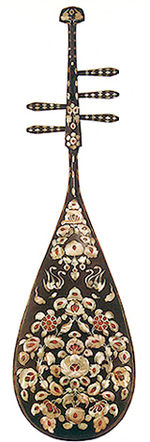
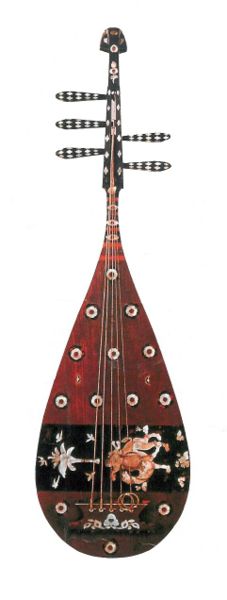
RepertoireThere are numerous pipa pieces in the common repertoire which can be split into four distinctive styles: 「文」 wen (civil), 「武」 wu (martial), 「大」 da (suite), and 「小」 xiao (solo).
Famous Pieces Include
Ambushed from Ten Sides (simplified Chinese: 《十面埋伏》; pinyin: Shí Mìan Maí Fú)
Flute and Drum at Sunset (simplified Chinese: 《夕陽簫鼓》; pinyin: Xī Yáng Xīao Gǔ")
White Snow in Spring Sunlight (simplified Chinese: 《陽春白雪》; pinyin: Yáng Chūn Baí Xuě")
Dragon Boat (simplified Chinese: 《龍船》; pinyin: Lóng Chuán")
Dance of the Yi People (simplified Chinese: 《彝族舞曲》; pinyin: Yì Zú Wú Qǔ")
Big Waves Pushing the Sand (simplified Chinese: 《大浪淘沙》; pinyin: Dà Làng Táo Shā)
Zhaojun Outside the Frontier (simplified Chinese: 《昭君出塞》; pinyin: Zhào Jūn Chū Saì)
King Takes Off His Armour (simplified Chinese: 《霸王卸甲》; pinyin: Bà Wáng Xiè Jiǎ)
Green Waist (simplified Chinese: 《绿腰》; pinyin: Lǜ Yāo).
Moonlit River in Spring (simplified Chinese: 《春江花月夜》; pinyin: Chūn Jiāng Huā Yuè Yè).
On top of these traditional melodies, new pieces are constantly being composed, most of which follow a more Western structure.
Use in contemporary classical musicIn the late 20th century, largely through the efforts of Wu Man, Min Xiao-Fen, and other performers, Chinese and Western contemporary composers began to create new works for the pipa (both solo and in combination with chamber ensembles and orchestra). Most prominent among these are Terry Riley, Philip Glass, Lou Harrison, Tan Dun, Bright Sheng, Chen Yi, Zhou Long, Bun-Ching Lam, and Carl Stone.
PerformersIn the 20th century, two of the most prominent pipa players were Sun Yude (孙裕德; 1904-1981) and Li Tingsong (李庭松; 1906-1976). Both were pupils of Wang Yuting (1872–1951), and both were active in establishing and promoting guoyue (国乐; literally "national music"), a combination of traditional regional musics and Western musical practices. Sun performed in the United States, Asia, and Europe, and in 1956 became deputy director of the Shanghai minzu yuetuan (上海民族乐团; Shanghai Folk Orchestra). As well as being one of the leading pipa players of his generation, Li held many academic positions and also carried out research on pipa scales and temperament. Wei Zhongle (卫仲乐; 1908 or 1909-1998) played many instruments, including the guqin. In the early 1950s, he founded the traditional instruments department at the Shanghai Conservatory of Music.
Lin Shicheng (林石城; 1922-2006), born in Shanghai, began learning music under his father and was taught by Shen Haochu (沈浩初; 1899–1953), a leading player in the Pudong (浦东) school style of pipa playing. He also qualified as a doctor of Chinese medicine. In 1956, after working for some years in Shanghai, Lin accepted a position at the Central Conservatory of Music in Beijing. Liu Dehai (刘德海; b. 1937) also born in Shanghai, was a student of Lin Shicheng and in 1961 graduated from the Central Conservatory of Music in Beijing. Liu also studied with other musicians and has developed a style that combines elements from several different schools.
Prominent students of Lin Shicheng include Liu Guilian (刘桂莲, b. 1961), Wu Man (吴蛮, b. 1963) and Gao Hong (高虹, b. 1964). Wu, who is probably the best known pipa player internationally, received the first-ever master's degree in pipa and won China's first National Academic Competition for Chinese Instruments. She lives in San Diego, California and works extensively with Chinese, cross-cultural, new music, and jazz groups. Shanghai-born Liu Guilian graduated from the Central Conservatory of Music and became the director of the Shanghai Pipa Society, and a member of the Chinese Musicians Association and Chinese National Orchestral Society, before immigrating to Canada. She now performs with Red Chamber and the Vancouver Chinese Music Ensemble. Gao Hong graduated from the Central Conservatory of Music and was the first to do a joint tour with Lin Shicheng in North America. They recorded the critically-acclaimed CD Hunting Eagles Catching Swans together.
Other contemporary players who have introduced the pipa to North America, Europe, or Japan include Min Xiao-Fen, Zhou Yi (周懿), Yang Wei (楊惟), Guan Yadong(管亚东), Tang Liangxing (湯良興), Jiang Ting, Qiu Xia He, Liu Fang (劉芳), Yang Jing(楊靜), Yang Jing(楊靖), Ting Ting (Zong Tingting), Cheng Yu, Jie Ma (马捷), and Changlu Wu(吳长璐).
Prominent pipa players in China include Yu Jia (俞嘉), Wu Yu Xia (吳玉霞), Zhang Qiang (張強), Fang JinLung (方錦龍), and Fan Wei (樊薇).
A Sui Dynasty (581–618) terra cotta pipa-player in a suit of armor
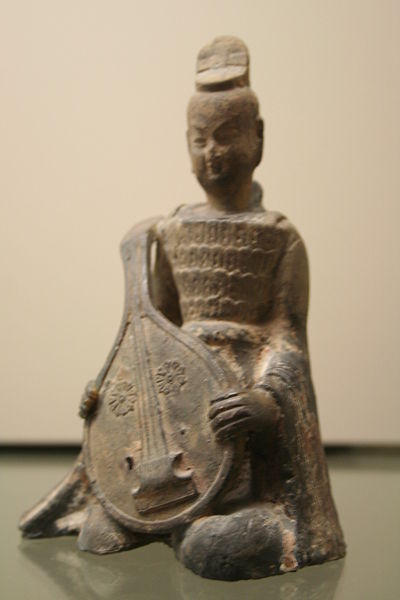
Use in other genresThe pipa has also been used in rock music; the California-based band Incubus featured it in their 2001 song "Aqueous Transmission," as played by the group's guitarist, Mike Einziger. The Shanghai progressive/folk-rock band Cold Fairyland, which was formed in 2001, also use pipa (played by Lin Di), sometimes multi-tracking it in their recordings. Australian dark rock band The Eternal use the pipa in their song 'Blood' as played by singer / guitarist Mark Kelson on their album 'Kartika'.
Electric Pipa
An electric pipaThe electric pipa was developed in the late 20th century by adding electric guitar-style magnetic pickups to a regular acoustic pipa, allowing the instrument to be amplified through an instrument amplifier or PA system.
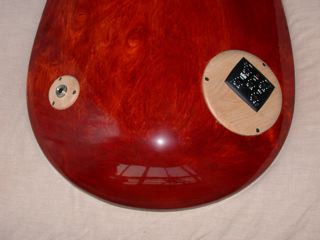
muzicafe :: KLASİK MÜZİK :: HAFİF MÜZİK :: ŞARKI SÖZLERİ :: MUZİCAFE SÖYLEŞİLER
1 sayfadaki 1 sayfası
Bu forumun müsaadesi var:
Bu forumdaki mesajlara cevap veremezsiniz